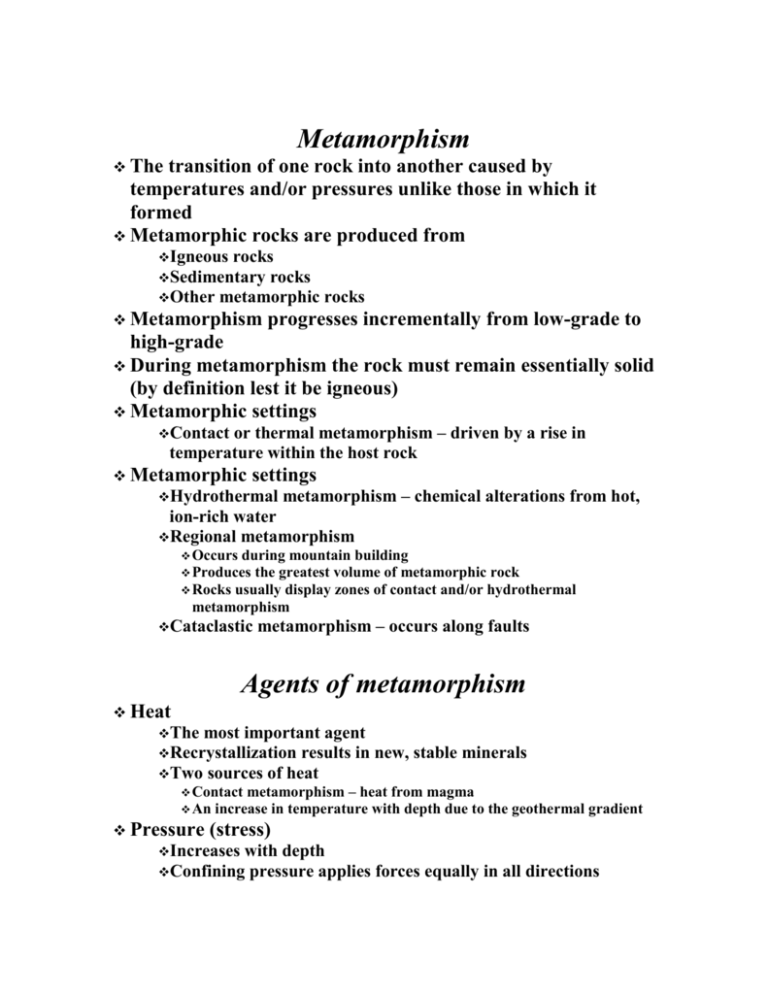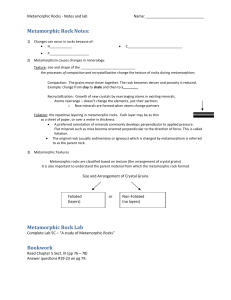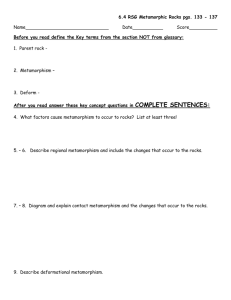Notes For Chapter 10 - Metamorphism
advertisement

Metamorphism The transition of one rock into another caused by temperatures and/or pressures unlike those in which it formed Metamorphic rocks are produced from Igneous rocks Sedimentary rocks Other metamorphic rocks Metamorphism progresses incrementally from low-grade to high-grade During metamorphism the rock must remain essentially solid (by definition lest it be igneous) Metamorphic settings or thermal metamorphism – driven by a rise in temperature within the host rock Contact Metamorphic settings Hydrothermal metamorphism – chemical alterations from hot, ion-rich water Regional metamorphism Occurs during mountain building Produces the greatest volume of metamorphic rock Rocks usually display zones of contact and/or hydrothermal metamorphism Cataclastic metamorphism – occurs along faults Agents of metamorphism Heat The most important agent Recrystallization results in new, stable minerals Two sources of heat metamorphism – heat from magma An increase in temperature with depth due to the geothermal gradient Contact Pressure (stress) Increases with depth Confining pressure applies forces equally in all directions Rocks may also be subjected to differ-ential stress which is unequal in different directions (produces foliation) Origin of pressure in metamorphism Chemically active fluids Mainly water with other volatile com-ponents Enhances migration of ions Aids in recrystallization of existing minerals Chemically Sources active fluids of fluids Sea water around mid-oceanic ridges from emplaced plutons Pore spaces of sedimentary rocks Hydrated minerals such as clays and micas Volatiles The importance of parent rock Most metamorphic rocks have the same overall chemical composition as the parent rock from which they formed (except for loss of volatiles H2O and CO2) Mineral makeup determines, to a large extent, the degree to which each metamorphic agent will cause change Metamorphic textures Texture refers to the size, shape, and arrangement of grains within a rock Foliation – any planar arrangement of mineral grains or structural features within a rock Examples Parallel of foliation alignment of platy and/or elongated minerals Foliation Examples of foliation Parallel alignment of flattened mineral grains and pebbles Compositional banding Slaty cleavage where rocks can be easily split into thin, tabular sheets Foliation Foliation can form in various ways including Rotation of platy and/or elongated minerals Recrystallization of minerals in the direction of preferred orientation Changing the shape of equidimensional grains into elongated shapes that are aligned (stretching) Development of foliation due to directed pressure Microscopic View of Foliation Foliated textures Rock or slaty cleavage Closely spaced planar surfaces along which rocks split develop in a number of ways depending on metamorphic conditions and parent rock In slate, the rock exhibits cleavage by the way it breaks rather than with visible grains Foliation is not bedding, but may resemble it Can Foliated textures Schistosity Platy minerals are discernible with the unaided eye and exhibit a planar or layered structure Rocks having this texture are referred to as schist More than 50% platy minerals, most common in the micas Foliated textures Gneissic During higher grades of metamorphism, ion migration results in the segregation of minerals Gneissic rocks exhibit a distinctive banded appearance of light and dark minerals, mineral content often resembles granitic rocks Other metamorphic textures Those metamorphic rocks that lack foliation are referred to as nonfoliated Develop in environments where stress is applied from all directions composed of minerals that exhibit equidimensional crystals Typically Other metamorphic textures Porphyroblastic textures Large grains, called porphyroblasts, surrounded by a fine-grained matrix of other minerals Porphyroblasts are typically garnet, staurolite, and/or andalusite Common metamorphic rocks Foliated rocks Slate Very fine-grained Excellent rock cleavage Most often generated from low-grade metamorphism of shale, mudstone, or siltstone May be difficult to differentiate from parent rock Slaty Cleavage Foliated rocks Phyllite Gradation in the degree of metamorphism between slate and schist Platy minerals not large enough to be identified with the unaided eye Glossy sheen and wavy surfaces Exhibits rock cleavage Composed mainly of fine crystals of muscovite and/or chlorite Phyllite and Slate lack visible mineral grains Foliated rocks Schist Medium- to coarse-grained minerals predominate (must be >50%) Commonly include the micas The term schist describes the texture To indicate composition, mineral names are used (such as mica schist, or garnet-muscovite schist) Platy Muscovite Schist Foliated rocks Gneiss Medium- to coarse-grained appearance (segregation of light and dark minerals) High-grade metamorphism Often composed of white or light-colored feldspar-rich layers with bands of dark ferromagnesian minerals Banded Gneiss typically displays a banded appearance Gneiss Nonfoliated rocks Marble Coarse, Parent crystalline rock was limestone or dolostone Composed essentially of calcite or dolomite crystals Used as a decorative and monument stone Exhibits a variety of colors Has a distinctive rough (almost tacky) feel Marble – a nonfoliated metamorphic rock Marble in the Microscope Nonfoliated rocks Quartzite Formed from a parent rock of quartz-rich sandstone grains are fused together Resembles sandstone, but breaks through grains rather than between grains Quartz Quartzite Metamorphic environments Contact or thermal metamorphism Occurs due to a rise in temperature when magma invades a host rock A zone of alteration called an aureole (baked contact) forms in the rock surrounding the magma Most easily recognized when it occurs at the surface, or in a near-surface environ-ment Contact metamorphism Hydrothermal metamorphism Chemical alteration caused when hot, ion-rich fluids, called hydrothermal solutions, circulate through fissures and cracks that develop in rock Most widespread along the axis of the mid-ocean ridge system Regional metamorphism Produces the greatest quantity of metamorphic rock Associated with mountain building at convergent plate boundaries Regional metamorphism Other metamorphic environments Burial metamorphism Associated with very thick sedimentary strata Required depth varies from one location to another depending on the prevailing geothermal gradient Metamorphism Occurs along fault zones (cataclastic) at depth and high temperatures minerals deform by ductile flow may produce Mylonite Pre-existing Other metamorphic environments Impact metamorphism Occurs when high speed projectiles called meteorites strike Earth’s surface Products are called impactiles (includes tektites) Metamorphic rocks and associated environments Metamorphic zones Systematic variations in the mineralogy and often the textures of metamorphic rocks are related to the variations in the degree of metamorphism Index minerals and metamorphic grade Changes in mineralogy occur from regions of low-grade metamorphism to regions of high-grade metamorphism Certain minerals can be an index to metamorphic grade Metamorphic Index Minerals Metamorphic zones in the Northeastern United States Metamorphic zones Migmatites Highest grades of metamorphism that is transitional to igneous rocks Contain light bands of igneous components along with areas of unmelted metamorphic rock Metamorphism and Plate Tectonics Ancient Metamorphic Environments Make up large portions of stable continental interiors called Shields (basement part of cratons) Very ancient rocks (up to 3.8 BYA) that represent the interiors of mountain ranges Suggest that the crust will eventually be entirely continental Key Terms Chapter 10 Metamorphism (low to high grade) Foliation Slaty cleavage Schistosity Slate Phyllite Gneiss Quartzite Marble Migmatite Contact, regional, burial metamorphism Metamorphic facies








